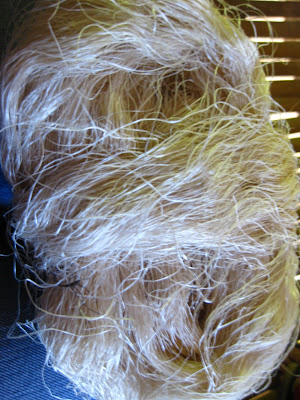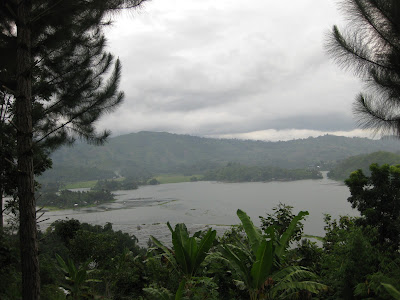I wouldn't bore everyone with my thesis but here's some bit of excerpt from it to introduce you to the Dreamweavers.
The Dreamweavers are called as such because their designs are more than cultural expressions -- they were woven dreams based on creatures of their everyday lives. Eagles, ferns, frogs, and hunters come alive through the designs that these women make with their bare hands. Exactly how the T'nalak is made, read below:
The whole process of producing T'nalak takes about four months with several women, and men helping each other through the whole process. The T'boli people no longer produce their own abaca fibers, unlike their ancestors before, they buy the fibers from other producers in Lake Sebu. One bundle of T'nalak would cost them fifteen pesos, they would normally use 25 bundles to produce 6 meters of T'nalak. After the abaca is purchased, one of the women would then sit and with the help of sunlight streaming into the long house, she would select which ones of the abaca would be used as vertical fibers and which one would go in to make the horizontal ones. After the fibers are selected, each one would be tied with the finest knots to make sure some parts don't get dyed and the design patterned in the weavers head would be translated properly into the weave.
After the arduous process of tying which usually takes one full day, the abaca fibers are dyed with leaves and barks which grows locally in the area. In order to give the cloth its vibrant color, the fibers have to be boiled for three weeks. Thereafter, the fibers are air dried. Once everything is prepared, the woman then sits in the longhouse and shuttles the thread back and forth pushing the threads to tighten with a flat piece of coco wood. She pushes it with three thuds. It is tight enough if the light does not stream through when the T'nalak is held up. She repeats the process over and over again. It is easy to see how a machine may be used to take over these tasks with each design being programmed into machines that would churn out 6 meters in no time.
The production does not end after the last thread is incorporated, the T'nalak is given a sheen. To do this, the cloth is beaten and the rounded fibers are flattened to catch the light. The cloth is then rubbed with beeswax and burnished with a cowrie shell. These is done by the T'boli men. In the olden times, after this is done, the T'nalak is rolled and wrapped in cloth. It is not displayed or used except on special occasions. The sanctity of the T'nalak before lies in the fact that not only is it prohibited to step on it, but it is likewise prohibited to cut the same. This days, however; the finished work is either shipped, prepared for pickup by the contractor, or stored to be shown to tourists visiting Lake Sebu. Moreover, the T'boli's now put specific demarcation marks on the cloth, usually at 3 meters, where it may be cut.
 |
| Upon my arrival at Lake Sebu I couldn't help getting overwhelmed by the site of the Lake. The incredibly blue skies and heralding clouds completed the warm welcome. |
 |
| Lunch for me was at Mountain Lodge. The Mountain Lodge is a project of ICTUS. Seen on this photo are solar panels which are true to the thrust of ICTUS to provide sustainable tourism. |
 |
| The morning I woke up it was with the sun and blue skies reflected on a lake. Immediately after seeing this site, I knew this day would be perfect. |
 |
| She said this pattern is 'given' to her by a hunter in her dream and hence the sphere patterns. |
 |
| Abaca -- the raw material for T'nalak |
 |
| Lunch was at Punta Isla where we have the Lake Sebu version of Sutukil. I liked their kinilaw more than Cebu, actually. |
 |
| Next morning is a trip on a skylab (a motorbike), going to the seven falls where I had a ta-dan zipline! |
 |
| The first of the seven falls. The current is too strong it's hard to go near let alone swim. |
 |
| The current is too strong it creates a mist on the rocks nearby |
 |
| Picturesque hike up the second falls, on the way to the zip line. |
 |
| Look Ma, I can fly! :) The view from the zipline is A-M-A-Z-I-N-G |
 |
| I took this photo while suspended in the middle of the 2nd leg of the zipline. Before I left the morning after, I took a photo of this lotus pond behind the cottage. |
From Manila you can take a plane to Gen San (the easiest route) and from Gensan go to the Yellow Bus station, just ask the cab from the airport, going to Marbel, Koronadal. From Marbel you can take another bus to Surallah and from Surallah you can take a van to Lake Sebu.
One of the nicer resorts in Lake Sebu is Punta Isla. I don't regret not going there, however; in favor of the cheaper Balben Cove where no other tourist can disturb me while I write my paper. This Nov 6-9 will be the fiesta of Lake Sebu (called Helobung), and I hope I can be back then. Meanwhile, I hope to finish my paper asap.
*Dreams for Sale. Intellectual Property of the Dreamweavers. Still on it's working draft.






What an amazing place!
ReplyDeleteVisit Sarses Paradise Resort in Tboli, perfect base camp for your climb to Lake Holon.
ReplyDeletehttp://www.sarsparadiseresort.weebly.com